Richard and Diane Van Vleck Personal Pages
The Home Habitat |
Making and using a blind in the home habitat

All home habitats come equipped with one ready made blind
for observing wildlife - the house. All we need do to get
close to several species of birds is to place a bird feeder in
front of a convenient window or even on the window sill,
itself, and then, sit back and watch the show.
However, on all but the smallest properties, there is
much more to be seen than what takes place at a bird feeder.
And, while a daily walk on a well-trodden path will frequently lead to a pleasant surprise, most creatures will hear or see us and disappear into the landscape long before we see
them. The key to discovery in the home habitat is sitting still
and keeping quiet. And, if, at the same time, we are hidden
from view, so much the better. Using a blind not only hides
us, but allows us some limited movement. We can fiddle
with cameras and scopes, take notes, and fidget to our heart's
content, while remaining undetected by surrounding wildlife.
Only after the torture of trying to remain motionless for
many minutes amidst deer flies and mosquitoes can one
appreciate the ecstacy of having freedom to fidget.
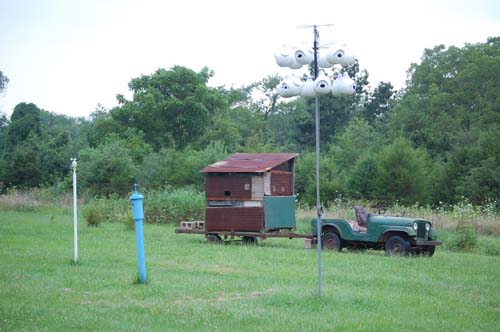 Blind Construction
Blind Construction
Portable blinds designed to be used away from home must
easily break down to a compact unit for carrying in a back
pack or a crowded car trunk. However, a blind to be used
only on your property need not necessarily break down at all
if it is light enough to carry. Or, it may be constructed of five
panels that hook or bolt together to form the four walls and
roof, with one wall being hinged for access.
The ideal summer blind is well ventilated, including a
vent near the top to allow hot air to move upward and escape.
It should also be light in color to reflect sunlight. A winter
blind is better made as tight as possible. Outdoor plywood or
other salvaged building material can be used for the panels
of a winter blind.
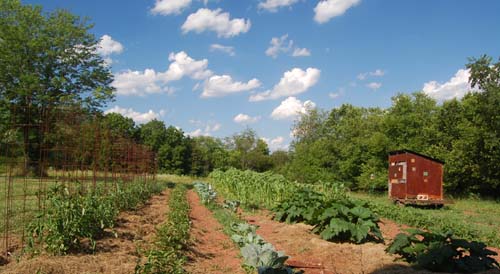 While commercial blinds are usually made of camouflage canvas, I doubt there is an advantage in trying to make your blind appear to be something else. Wildlife living near
humans are afraid of us, but not of our inanimate possessions. Once a blind is left in place for a few days, surrounding wildlife accept it as part of their natural world. A red fox
has entered my canvas blind and a great blue heron has landed on top of it.
While commercial blinds are usually made of camouflage canvas, I doubt there is an advantage in trying to make your blind appear to be something else. Wildlife living near
humans are afraid of us, but not of our inanimate possessions. Once a blind is left in place for a few days, surrounding wildlife accept it as part of their natural world. A red fox
has entered my canvas blind and a great blue heron has landed on top of it.
A variety of material can be used to cover a summer
blind. An aluminum pipe frame covered with muslin served
as my creek blind for five years, until sudden high water
washed it away to the river. The cheapest, and, perhaps the
worst choice is the plastic drop cloth. Plastic doesn't breath
like canvas, and, makes an annoying noise in even the
slightest breeze. It also has a short life, especially when
exposed to sunlight day after day.
The dimensions of your blind should conform to your
specific needs. First, choose the seat you intend to use and
any photo equipment, including a tripod, if one is to be used.
By putting this equipment in position and sitting on the seat,
you will be able to measure the dimensions you require.
Allow yourself enough headroom to sit up and stretch, and,
set the tripod high enough to avoid getting a stiff neck during
prolonged use.
The observation opening can simply be a slit through
which the camera or scope can protrude, or, it can be a large
opening with a flap to tie closed when not in use. The
entrance to the blind can be a flap with several ties or a
zipper. I use ties simply so I will never have to deal with a
stuck zipper. Ideally the top should slope, or, at least, not sag
so much as to collect a large pool of rain water.
Anchoring the blind can be done with conventional tent
stakes and ropes, unless it is heavy enough to not require it.
The blind can also be secured to objects such as fence posts
or trees.
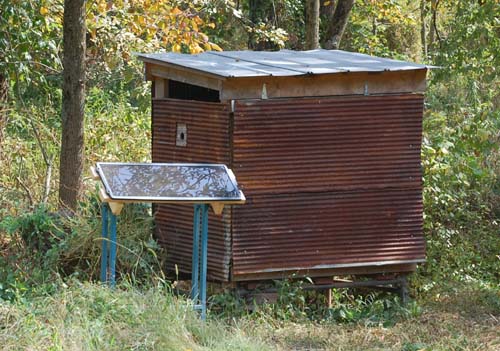 The Creek blind
The Creek blind
This blind along the creek was built from all recycled material. It has a floating floor which has withstood several floods. The solar panel keeps a deep cycle marine battery charged to power video equipment and a laptop. The solar panel can be moved to other locations and the battery is removed from the jeep when needed at the blind.
Using Your Blind
You will probably already have one or more sites planned for
locating your blind before you build it. Any water source will
likely produce some interesting observations, including a
garden pond or the smallest creek. Field edges, fence rows,
and forest edges are good bets, also. But, previous experience will be your best guide. For instance, if you have observed from a distance an owl or hawk or kingfisher using
a snag, you can finally get a closer look by setting up your blind nearby. Luckily, almost any location in a well planted yard will likely turn up some interesting discoveries.
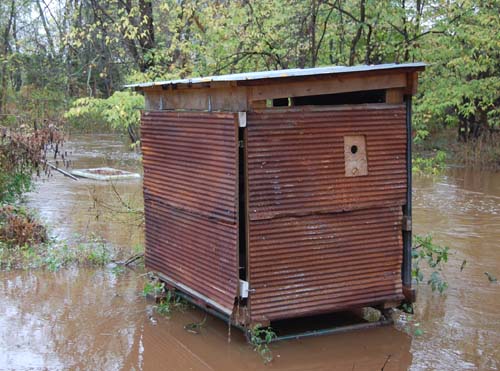 After deciding on a likely area, the exact location of the
blind will be determined by visibility, lighting at the time of
day you plan to use the blind, and, easy access to the blind
without disturbing the subject. Perhaps the most effective
time to use a blind is very early in the morning. This means
entering the blind well before sunrise. But, if this isn't your
style, mid morning and evening are pretty good times also.
Mid day in summer is a pretty slow time for birds and
mammals. Whatever time you plan to use the blind, be sure
the sun won't be in your eyes. Also, if the blind can be
located in the shade of a tree, so much the better.
After deciding on a likely area, the exact location of the
blind will be determined by visibility, lighting at the time of
day you plan to use the blind, and, easy access to the blind
without disturbing the subject. Perhaps the most effective
time to use a blind is very early in the morning. This means
entering the blind well before sunrise. But, if this isn't your
style, mid morning and evening are pretty good times also.
Mid day in summer is a pretty slow time for birds and
mammals. Whatever time you plan to use the blind, be sure
the sun won't be in your eyes. Also, if the blind can be
located in the shade of a tree, so much the better.
Your blind can also be an excellent retreat from an all
too hectic life, allowing you to focus your attention on things
like bull frogs and muskrats, if you wish. You may want to
hang a "Do not disturb" sign on the back of your blind, the
side facing toward civilization.
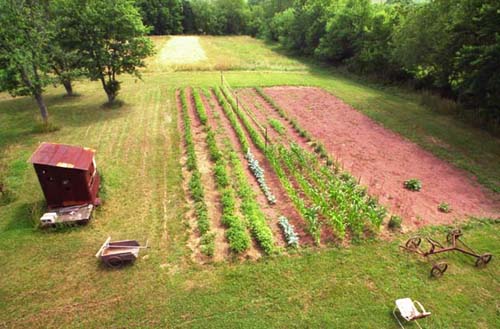 Front yard blind A similar scaffold and roofing metal blind at the front yard flicker cavity. I actually erected this blind to photograph the flickers at their nest site, however, they were driven off by starlings the next day. I then used the upstairs porch door as a shooting blind to remove many starlings from the sycamores.
Front yard blind A similar scaffold and roofing metal blind at the front yard flicker cavity. I actually erected this blind to photograph the flickers at their nest site, however, they were driven off by starlings the next day. I then used the upstairs porch door as a shooting blind to remove many starlings from the sycamores.
Inside a sunflower stalk blind at the front yard pond. The stalks are all cut to a uniform length in a straw cutter and wired together near the top, bottom and center to form a flexible mat. Holes are cut for windows after wiring around each opening. The mat is drawn into a spiral, forming a door in the rear. The blind can be rolled up for storage and will last many years if stored out of the weather when not in use.
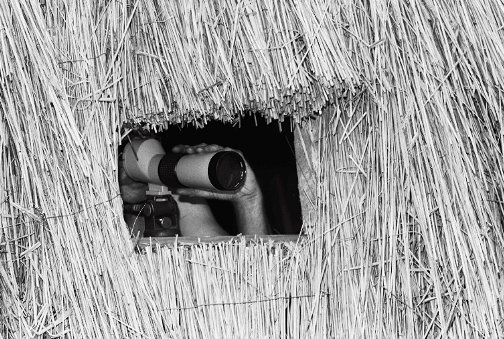 Thached blinds have a neater appearance than sunflower or corn stalks and can be waterproof. A garden cover crop of rye will give you enough straw to thatch a blind or a shelter roof. You will need to wait until mid summer to harvest the rye, so early vegetables will have to go elsewhere that year. The grain should be threshed with a flail to avoid breaking the stems. I have simply clipped off the heads before threshing, thus keeping the straw aligned just as I cut it with a cradle or grain binder. Thatch with the butts down and each tier overlapping about 1/3 to 1/2 its length. But, don't forget to thresh out the grain, or birds and mice will do it for you.
Thached blinds have a neater appearance than sunflower or corn stalks and can be waterproof. A garden cover crop of rye will give you enough straw to thatch a blind or a shelter roof. You will need to wait until mid summer to harvest the rye, so early vegetables will have to go elsewhere that year. The grain should be threshed with a flail to avoid breaking the stems. I have simply clipped off the heads before threshing, thus keeping the straw aligned just as I cut it with a cradle or grain binder. Thatch with the butts down and each tier overlapping about 1/3 to 1/2 its length. But, don't forget to thresh out the grain, or birds and mice will do it for you.
A winter blind This was my first blind. Not very imaginative, but it lasted quite a few years until it was swept away in a a raging creek, along with an old tripod. Now I tend to use permanent blinds made from whatever materials I can salvage.
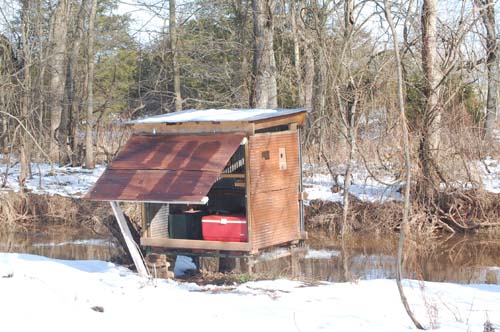
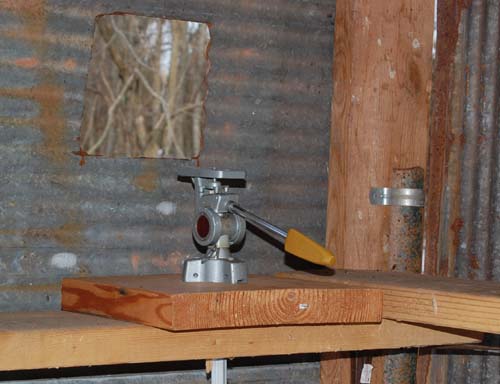
In the creek blind, rather than use a tripod, I affixed a 2x6 plank shelf on the three viewing sides and drilled a hole in the shelves under each camera port to receive the post of a tripod head. This allows the tripod head and camera to be instantly moved to another cam port. It also positions the camera close to the wall and eliminates the sprawling tripod legs.
A small table in the trailer blind provides space for a laptop to enable working while waiting for the intended subject to arrive. The creek blind shelves also provide space for a laptop and video equipment for monitoring a turtle float.
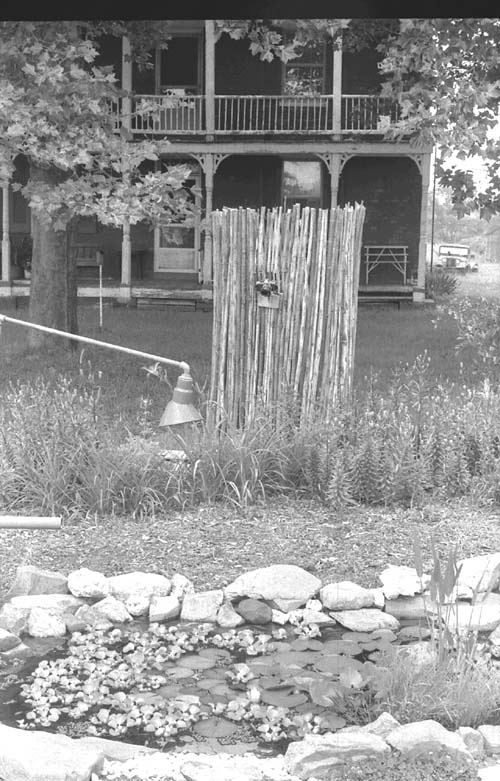
The sunflower stalk blind doesn't have a roof and allows good airflow between the stalks. The one at right is now well over 10 years old, but it has been stored in a building when not in use and has only been used 4 or 5 times.
Use of nest boxes and nest box traps by starlings and house sparrows
the house sparrow in America
the European starling in America
the pellet gun - a valuable tool in house sparrow and starling control
American Artifacts home
email richard@americanartifacts.com
© 2002 - 2013, American Artifacts and Richard Van Vleck, Taneytown, Maryland.


 Thached blinds have a neater appearance than sunflower or corn stalks and can be waterproof. A garden cover crop of rye will give you enough straw to thatch a blind or a shelter roof. You will need to wait until mid summer to harvest the rye, so early vegetables will have to go elsewhere that year. The grain should be threshed with a flail to avoid breaking the stems. I have simply clipped off the heads before threshing, thus keeping the straw aligned just as I cut it with a cradle or grain binder. Thatch with the butts down and each tier overlapping about 1/3 to 1/2 its length. But, don't forget to thresh out the grain, or birds and mice will do it for you.
Thached blinds have a neater appearance than sunflower or corn stalks and can be waterproof. A garden cover crop of rye will give you enough straw to thatch a blind or a shelter roof. You will need to wait until mid summer to harvest the rye, so early vegetables will have to go elsewhere that year. The grain should be threshed with a flail to avoid breaking the stems. I have simply clipped off the heads before threshing, thus keeping the straw aligned just as I cut it with a cradle or grain binder. Thatch with the butts down and each tier overlapping about 1/3 to 1/2 its length. But, don't forget to thresh out the grain, or birds and mice will do it for you.
